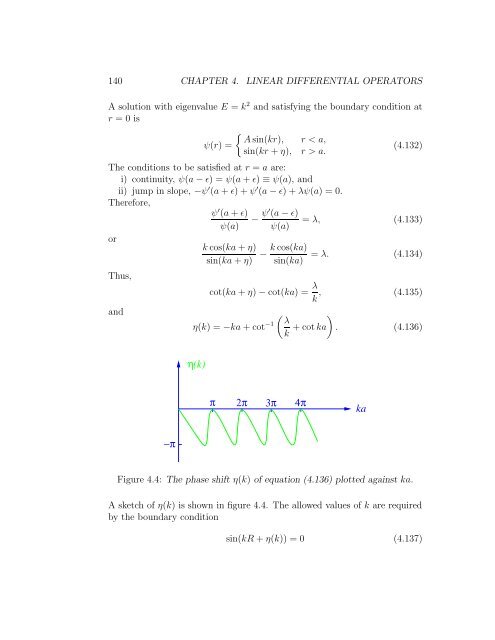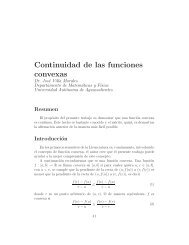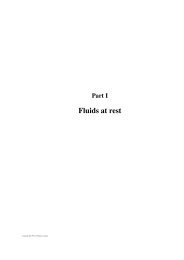Chapter 4 Linear Differential Operators
Chapter 4 Linear Differential Operators
Chapter 4 Linear Differential Operators
You also want an ePaper? Increase the reach of your titles
YUMPU automatically turns print PDFs into web optimized ePapers that Google loves.
140 CHAPTER 4. LINEAR DIFFERENTIAL OPERATORS<br />
A solution with eigenvalue E = k2 and satisfying the boundary condition at<br />
r = 0 is<br />
<br />
A sin(kr), r < a,<br />
ψ(r) =<br />
(4.132)<br />
sin(kr + η), r > a.<br />
The conditions to be satisfied at r = a are:<br />
i) continuity, ψ(a − ɛ) = ψ(a + ɛ) ≡ ψ(a), and<br />
ii) jump in slope, −ψ ′ (a + ɛ) + ψ ′ (a − ɛ) + λψ(a) = 0.<br />
Therefore,<br />
ψ ′ (a + ɛ)<br />
ψ(a) − ψ′ (a − ɛ)<br />
= λ, (4.133)<br />
ψ(a)<br />
or<br />
Thus,<br />
and<br />
−π<br />
k cos(ka + η)<br />
sin(ka + η)<br />
− k cos(ka)<br />
sin(ka)<br />
= λ. (4.134)<br />
cot(ka + η) − cot(ka) = λ<br />
, (4.135)<br />
k<br />
η(k) = −ka + cot −1<br />
η(k)<br />
π 2π 3π 4π<br />
<br />
λ<br />
+ cot ka . (4.136)<br />
k<br />
Figure 4.4: The phase shift η(k) of equation (4.136) plotted against ka.<br />
A sketch of η(k) is shown in figure 4.4. The allowed values of k are required<br />
by the boundary condition<br />
ka<br />
sin(kR + η(k)) = 0 (4.137)




